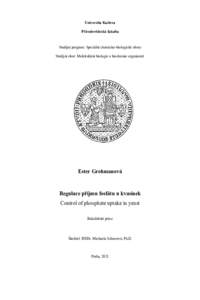Regulace příjmu fosfátu u kvasinek
Control of phosphate uptake in yeast
bakalářská práce (OBHÁJENO)

Zobrazit/
Trvalý odkaz
http://hdl.handle.net/20.500.11956/126169Identifikátory
SIS: 208426
Kolekce
- Kvalifikační práce [21483]
Autor
Vedoucí práce
Oponent práce
Heidingsfeld, Olga
Fakulta / součást
Přírodovědecká fakulta
Obor
Molekulární biologie a biochemie organismů
Katedra / ústav / klinika
Katedra genetiky a mikrobiologie
Datum obhajoby
28. 5. 2021
Nakladatel
Univerzita Karlova, Přírodovědecká fakultaJazyk
Čeština
Známka
Velmi dobře
Klíčová slova (česky)
Vysokoafinitní a nízkoafinitní transportéry, transkripční faktor Pho4, SPX doména, inositolpyrofosfáty, Saccharomyces cerevisiaeKlíčová slova (anglicky)
High-affinity and low-affinity transporters, transcription factor Pho4, SPX domain, inositolpyrophosphates, Saccharomyces cerevisiaeHomeostáze fosfátu je esenciální pro metabolismus buňky a regulaci buněčného cyklu. Regulace metabolis- mu fosfátu je závislá především na transkripčním faktoru Pho4, který stimuluje expresi některých genů pro vysokoafinitní a nízkoafinitní transportéry při nízké dostupnosti fosfátu v cytosolu. Teprve v poslední době bylo objeveno, že intracelulární dostupnost fosfátu buňka snímá pomocí inositolpyrofosfátů, jejichž vzájem- ný poměr ovlivňuje aktivitu nebo stabilitu regulačních i strukturních proteinů, které jsou součástí PHO regulonu, nepřímo i proteinu Pho4. Pro tyto proteiny je charakteristická přítomnost SPX domény, která inter- akci specifického izomeru inositolpyrofosfátu a proteinu zprostředkuje. Tato práce popisuje základní principy regulace hladiny a aktivity vybraných proteinů PHO regulonu v závislosti na intracelulární dostupnosti fosfátu na úrovni transkripční, posttranskripční a posttranslační, především u modelového organismu Saccharomyces cerevisiae. Teprve nedávno bylo zjištěno, že narušením homeostáze fosfátu lze u patogenních kvasinek C. albicans a C. neoformans inhibovat jejich virulenci. Podrobnější studie odhalily některé rozdíly ve způsobu regulace metabolismu fosfátu u různých druhů kvasinek. Detailní znalost interakcí proteinů PHO regulonu s virulenčními faktory je možné...
Phosphate homeostasis is essential for cell metabolism and cell cycle regulation. The regulation of phosphate metabolism depends mainly on the transcription factor Pho4, which stimulates the expression of some genes for high-affinity and low-affinity transporters under low phosphate conditions. It has only recently been dis- covered that intracellular phosphate availability is detected by means of inositol pyrophosphates, the ratio of which affects the activity or stability of regulatory and structural proteins that are part of the PHO regulon, and indirectly also the activity of the Pho4 protein. These proteins are characterized by the presence of SPX domain that mediates the interaction of a specific inositol pyrophosphate isomer and the protein. This thesis describes the main principles applied in the control of the level and activity of selected pro- teins of the PHO regulon in the model organism Saccharomyces cerevisiae. This complex control exploits transcriptional, posttranscriptional and posttranslational levels of gene expression regulation, few examples are presented in this thesis. It has only recently been found that disruption of phosphate homeostasis can inhibit the virulence pheno- type in the pathogenic yeasts C. albicans and C. neoformans. More detailed studies have revealed some...
